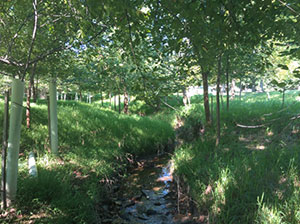Sustainable Homeowners Associations — Riparian Buffers

Definition
Riparian buffers are vegetated areas consisting of trees, shrubs and meadows adjacent to a pond, lake, stream, creek, river, or wetland. They significantly reduce stream bank erosion and filter harmful pollutants from fertilizers, pesticides, microplastics, and others, as well as sediments, from stormwater runoff, enhancing water quality. Riparian buffers also shade streams making them cooler for aquatic life. HOAs often own open spaces with riparian buffers that could be planted or improved.
Grants and Funding
Community & Watershed Forestry Program
Part of Community Conservation Partnership Program (C2P2), this program provides financial assistance to identify locations in need of riparian forest buffers, lawn conversion into meadows or woodland, community tree planting, and to design, implement, and establish those practices (those requesting TreeVitalize funding should apply here). Learn more.
Riparian Forest Buffer Program
Part of DCNR's C2P2 program, this program provides reimbursable grants to organizations to establish riparian buffer landowner outreach, buffer design, site preparation and buffer installation, plant materials and tree shelters, and short-term maintenance (within the 4-year grant period). Learn more.
Pennsylvania Association of Conservation Districts
PACD was awarded a $100,000 Community Conservation Partnerships Program Grant from the PA Department of Conservation and Natural Resources (DCNR) to offer Lawn Conversion training and mini-grants to Pennsylvania's conservation districts. The lawn conversion program will help the Commonwealth achieve a goal of planting 5,000 acres of upland forest and 5,000 acres of meadow by 2025. Learn more.
Watershed Grants
Part of PA DEP's Growing Greener grants, another opportunity to receive funds for a variety of projects including stormwater management and riparian buffers. Learn more.
TreeVitalize Watersheds Grant
Provides funding to non-profit and governmental organizations for upland and riparian tree plantings. Landowners may partner with a non-profit organization like a watershed association who can apply on their behalf. Eligible costs include trees (up to $25 average cost per tree); tree shelters; some site preparation; staff time for non-profits to do the project design, plant selection, ordering and receiving, volunteer recruitment and management, and administrative costs; and more. In Chester County, contact Cori Trice at the Chester County Conservation District for more information at ctrice@chesco.org. Learn more.
Keystone 10 Million Tree Partnership.
This program provides free trees and deer protection tubes and stakes to landowners each fall and spring. Chester County Conservation District coordinates the tree distribution with Brandywine Red Clay Alliance. Learn more.
Partner Organizations
- Some watershed organizations may have funding targeted for riparian buffers in your area. Contact your local watershed organization. View a list of organizations in Chester County.
- Chester County Conservation District
- Chester County Water Resources Authority
- Christina Watersheds Municipal Partnership (CWMP) works with municipalities to improve water quality with eight conservation organizations. Website has resources and conservation organizations may be able to help with your riparian buffer project.
- Penn State Extension Master Watershed Stewards work with organizations, communities, and private landowners on riparian buffer planning and planting. View local program contacts.
Education and Resources
- Landowner's Guide to Riparian Buffers
- DCNR's Streamside Buffers for Residential Properties fact sheet
- Fact sheet on using native vegetation to create riparian buffers
- Planning eTool for Riparian Buffers
- Basics on different types of riparian buffers with links to live staking and other restoration options.
- Growing Great Buffers webinar series
- (Forested) Riparian Buffers for Private Lands
- Brandywine Conservancy's Riparian Buffer Guide

